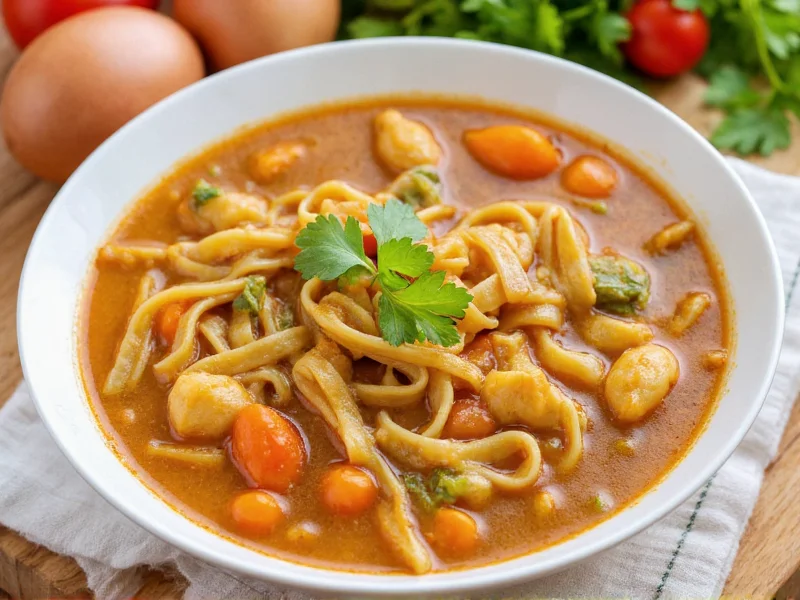Creating exceptional chicken noodle soup requires understanding the balance of ingredients and technique. This comprehensive guide delivers a foolproof method for making restaurant-quality soup at home, whether you're seeking comfort during cold season or simply craving a classic comfort food.
Why This Chicken Noodle Soup Recipe Works
Unlike many simplified versions, this easy chicken noodle soup recipe from scratch builds flavor through multiple stages. The secret lies in properly extracting collagen from chicken bones, which creates that signature silky texture and rich mouthfeel you can't achieve with store-bought broth alone.
Essential Ingredients and Substitutions
The foundation of any homemade chicken noodle soup with fresh vegetables starts with quality components:
| Ingredient | Why It Matters | Substitutions |
|---|---|---|
| Bone-in chicken thighs | Provides richer flavor and stays moist during simmering | Breasts (cook less time), rotisserie chicken (add at end) |
| Yellow onions | Sweetness balances the savory elements | Shallots, leeks |
| Fresh parsley | Adds brightness that dried herbs can't match | Celery leaves, chives |
| Egg noodles | Traditional texture that holds up in broth | Rice noodles (gluten-free), orzo, small pasta |
Step-by-Step Preparation Guide
Follow these steps for the best chicken broth for noodle soup with professional results:
Building the Flavor Foundation
- Place 2 pounds bone-in chicken thighs in a large pot with 8 cups cold water
- Add 1 chopped onion, 2 celery stalks, and 2 carrots (all roughly chopped)
- Include 4 garlic cloves, 1 bay leaf, and 1 teaspoon black peppercorns
- Bring to a gentle simmer (not boil) and skim foam that rises to the surface
- Cover and cook for 45 minutes until chicken reaches 165°F internally
Perfecting the Broth
Remove chicken and strain broth through a fine-mesh sieve. Return clear broth to pot. This step creates the healthy chicken noodle soup recipe with vegetables base that's free of impurities while retaining maximum flavor.
Final Assembly
- Shred chicken, discarding skin and bones
- Return broth to simmer and add 2 diced carrots and 2 diced celery stalks
- Cook 10 minutes until vegetables soften
- Add 8 ounces egg noodles and cook according to package directions
- Return chicken to pot with 2 tablespoons fresh parsley and 1 tablespoon fresh dill
- Season with salt to taste (start with 1 teaspoon)
Avoiding Common Chicken Noodle Soup Mistakes
Even experienced cooks make these errors when preparing classic chicken noodle soup:
- Boiling instead of simmering - Vigorous boiling makes broth cloudy and can toughen chicken
- Adding noodles too early - They absorb too much broth and become mushy (cook separately if meal prepping)
- Underseasoning - Broth needs more salt than you might expect; season in layers
- Overcooking vegetables - Add delicate vegetables later to maintain texture
Storage and Reheating Instructions
For optimal chicken noodle soup storage and reheating tips, follow these guidelines:
- Cool soup completely before storing (within 2 hours of cooking)
- Store broth and noodles separately if possible to prevent sogginess
- Refrigerate for up to 4 days or freeze for 3 months
- When reheating, add a splash of water or broth if needed to restore consistency
- Never boil when reheating - gentle simmer preserves texture
Variations for Different Dietary Needs
Adapt this authentic chicken noodle soup ingredients list for special requirements:
- Gluten-free version: Use rice noodles or gluten-free pasta alternatives
- Low-sodium option: Omit added salt and use low-sodium broth
- Quick weeknight version: Start with quality store-bought broth and rotisserie chicken
- Extra-vegetable version: Add zucchini, peas, or spinach during final minutes
Frequently Asked Questions
How long should chicken noodle soup simmer for best flavor?
For optimal flavor development, simmer your chicken noodle soup for 45-60 minutes after the initial broth preparation. This allows vegetables to soften while flavors meld together. Avoid simmering longer than 90 minutes total as vegetables may become mushy and flavors can turn bitter.
Can I make chicken noodle soup without鸡汤块 (chicken bouillon cubes)?
Absolutely. The best flavor comes from simmering bone-in chicken pieces with aromatic vegetables. If using store-bought broth, choose low-sodium versions and enhance with fresh herbs, garlic, and a splash of apple cider vinegar to mimic the depth of homemade broth without artificial additives.
What's the secret to preventing mushy noodles in chicken soup?
Cook noodles separately and add them to individual servings. If preparing the entire pot at once, undercook noodles by 2-3 minutes as they'll continue cooking in the hot broth. For meal prep, store noodles separately from broth and combine when reheating to maintain perfect texture.
Which vegetables hold up best in chicken noodle soup?
Carrots, celery, and parsnips maintain their texture well during cooking. Add delicate vegetables like zucchini, peas, or spinach during the last 5-10 minutes of cooking. For maximum nutritional benefit and texture variety, include a mix of hard and soft vegetables added at different stages.
How can I make my chicken noodle soup more flavorful without adding salt?
Enhance flavor naturally by toasting spices like black peppercorns before adding to broth, using mushroom trimmings for umami, adding a Parmesan rind while simmering, or finishing with fresh lemon juice and herbs. Roasting vegetables before adding to broth also creates deeper flavor through caramelization.











 浙公网安备
33010002000092号
浙公网安备
33010002000092号 浙B2-20120091-4
浙B2-20120091-4